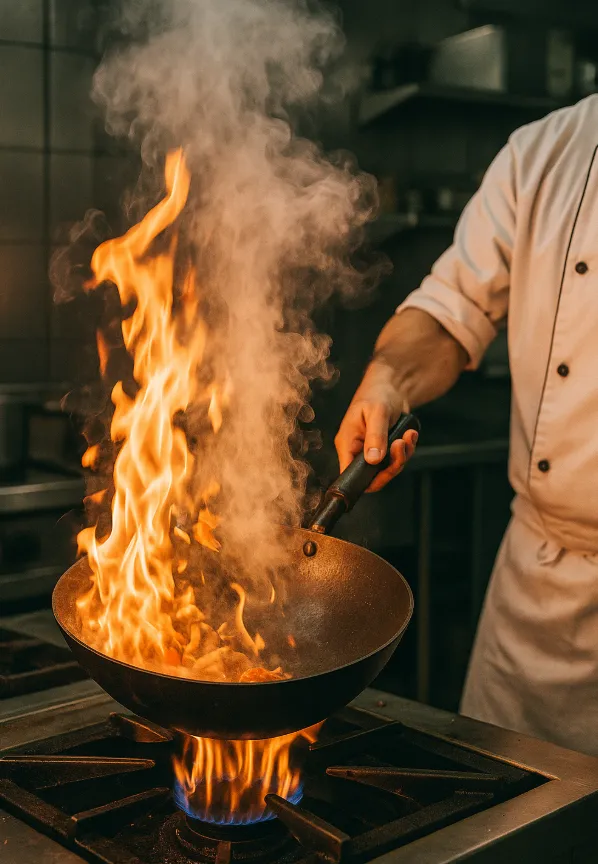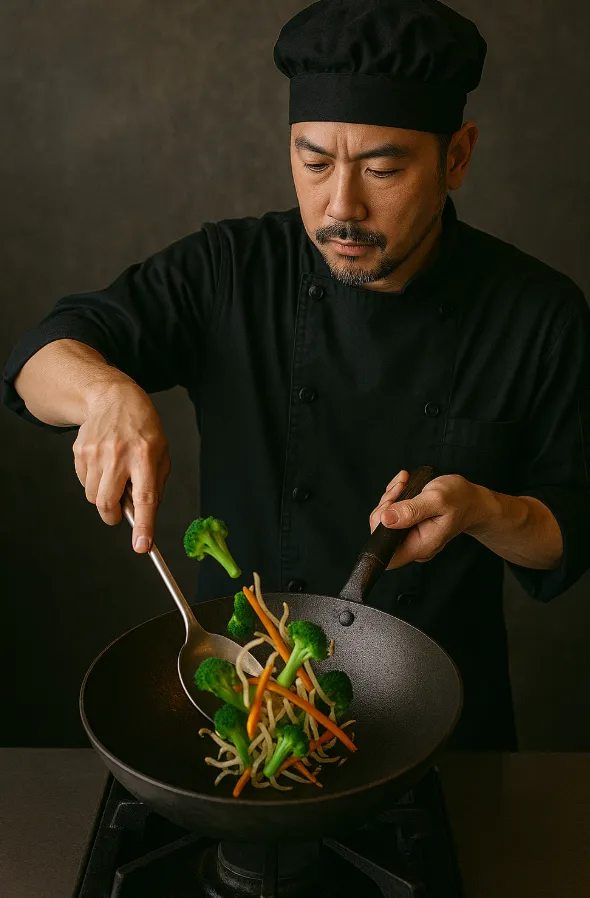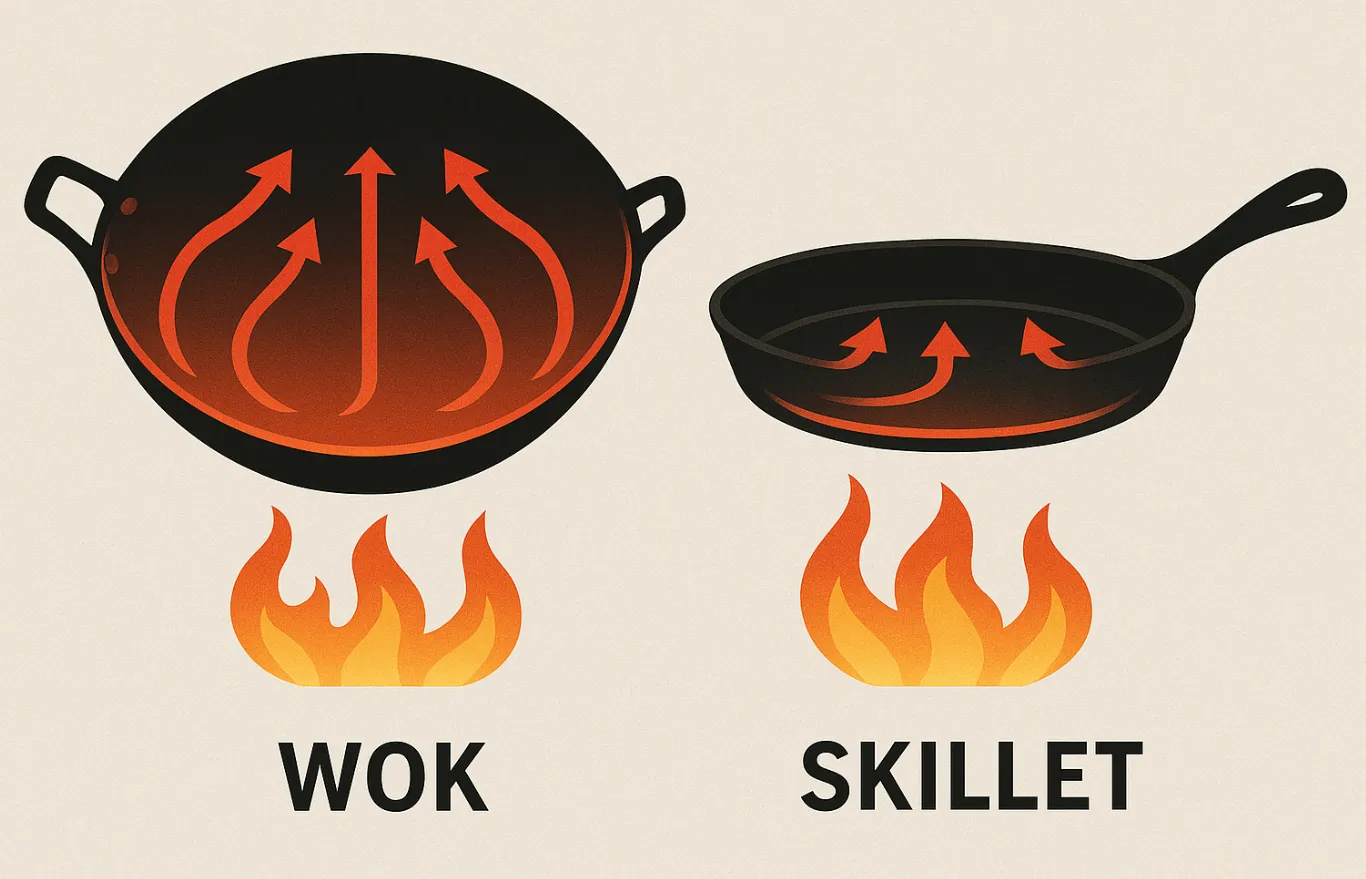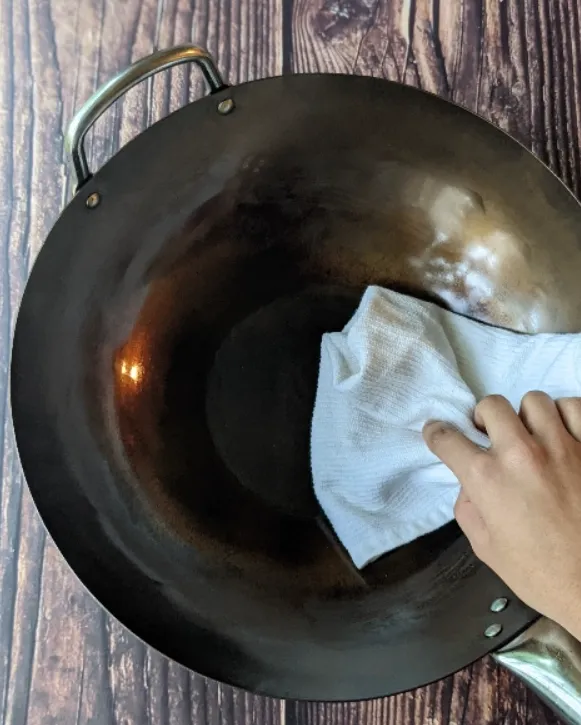Mastering Maillard Reactions in Wok Cooking: Temperature and Technique Guide
The Science of Perfect Browning: Maillard Reactions for Asian Stir-Fry Success
Understanding the chemistry behind wok hei and achieving restaurant-quality browning through proper temperature control and technique
The distinctive flavors and appealing appearance of authentic Asian stir-fry depend heavily on Maillard reactions—the complex chemical processes that create browning, develop savory flavors, and contribute to the legendary "wok hei" that distinguishes restaurant cooking from home attempts. This guide explores the science behind these reactions and provides practical techniques for mastering them in your own kitchen.

Understanding Maillard Reactions in Wok Cooking
Maillard reactions represent one of the most important chemical processes in high-heat Asian cooking, creating the complex flavors and appealing colors that define exceptional stir-fry results. These reactions occur when amino acids and reducing sugars interact under specific temperature conditions, producing hundreds of different flavor compounds.
{{< youtube SeuBSQjb2BQ 88 "made our reactions which take place between 250 degree to 300 degree Fahrenheit please see my video about Maillard reactions" >}}
According to this technical analysis, Maillard reactions begin occurring between 250-300°F (121-149°C), but achieving optimal results in wok cooking requires understanding the relationship between these reaction temperatures and the much higher oil temperatures needed for proper stir-frying technique.
Cultural Note: The pursuit of perfect browning through Maillard reactions forms the foundation of wok hei achievement, connecting modern food science with traditional Chinese cooking principles explored throughout our complete wok cooking series.
The Temperature Paradox: Oil Heat vs. Maillard Temperatures
While Maillard reactions occur at relatively moderate temperatures (250-300°F), successful wok cooking requires oil temperatures of 400°F or higher to ensure food surfaces reach the Maillard temperature range quickly while maintaining proper texture and moisture control.
This temperature differential explains why oil selection becomes crucial for achieving consistent Maillard reactions—oils must maintain stability at extreme temperatures while allowing rapid heat transfer to food surfaces.
The Science Behind Browning in Stir-Fry
Professional-level stir-frying creates optimal conditions for Maillard reactions through precise control of heat application, moisture management, and timing.
{{< youtube 2KNlXt0u_5o 181 "until mostly cooked through while becoming lightly browned in spots so the hottest spot of the walk is going to be this area down here" >}}
This demonstration reveals how proper wok technique creates ideal Maillard reaction conditions. The food achieves "lightly browned in spots" through brief contact with the wok's hottest zone, while the tossing motion prevents overcooking and maintains texture contrast.

Critical Success Factors for Maillard Development
1. Surface Temperature Achievement Food surfaces must reach 250-300°F quickly to initiate Maillard reactions while preventing moisture loss that inhibits browning.
2. Moisture Management Excess surface moisture prevents temperature rise and inhibits Maillard reactions. Proper preparation and cooking technique prioritizes rapid moisture evaporation.
3. Contact Time Control Brief, intense heat contact creates browning without overcooking, requiring precise timing and technique coordination.
4. Heat Distribution Optimization Wok shape and material properties concentrate heat in specific zones, enabling controlled Maillard reaction development.
Temperature Requirements and Oil Performance
The relationship between oil smoke points and Maillard reaction temperatures determines successful browning achievement in wok cooking applications.
Essential Temperature Ranges
| Process | Temperature Range | Critical Requirements |
|---|---|---|
| Maillard Reactions | 250-300°F (121-149°C) | Food surface temperature |
| Oil Performance | 400-500°F (204-260°C) | Heat transfer medium |
| Wok Surface | 500-600°F+ (260-316°C+) | Optimal heat source |
Science Note: The 150-250°F temperature gap between Maillard initiation and optimal oil performance explains why high smoke point oils become essential for consistent browning results.
Oil Selection for Maillard Optimization
Different oils provide varying levels of support for Maillard reaction development:
Premium Performance:
- Algae Oil (485-510°F): Exceptional thermal stability enables sustained high-heat cooking while supporting rapid surface browning
- Avocado Oil (520°F): Highest smoke point provides maximum temperature tolerance
- Peanut Oil (450°F): Traditional choice offering reliable performance with subtle flavor enhancement
Standard Options:
- Canola Oil (400°F): Adequate performance for most home applications with neutral flavor profile
- Grapeseed Oil (420°F): Light flavor with moderate high-heat capability
For comprehensive oil selection guidance, see our complete cooking oil analysis covering performance characteristics across different Asian cooking applications.
Practical Techniques for Maillard Mastery
Achieving consistent Maillard reactions in home wok cooking requires specific preparation and technique modifications to compensate for equipment limitations.

Pre-Cooking Preparation
Moisture Removal Priority Pat all ingredients completely dry before cooking. Surface moisture must evaporate before Maillard reactions can begin, consuming valuable heat energy and preventing proper browning.
Ingredient Sizing Cut ingredients into uniform pieces ensuring consistent heat exposure. Smaller pieces achieve surface temperature faster, promoting even Maillard development.
Temperature Staging Bring refrigerated ingredients to room temperature before cooking to reduce thermal load and enable faster surface heating.
Heat Management Strategies
Wok Preheating Protocol Heat the wok until water droplets instantly vaporize on contact, indicating surface temperatures exceeding 400°F and optimal conditions for rapid heat transfer.
Oil Addition Timing Add oil immediately before food addition to prevent thermal breakdown while ensuring maximum heat transfer capability when Maillard reactions matter most.
Batch Size Control Cook in smaller batches when using home equipment to maintain adequate heat levels for consistent browning across all ingredients.
Equipment Optimization for Browning Success
Wok material and setup choices significantly impact Maillard reaction development through heat transfer efficiency and temperature maintenance capability.
Carbon Steel Advantages Carbon steel woks develop seasoned surfaces that enhance heat transfer while contributing unique flavor compounds that complement Maillard reaction products. The material's thermal properties enable rapid temperature changes essential for controlled browning.
Heat Source Considerations Gas burners provide superior heat control for Maillard reaction management, while electric and induction surfaces require technique modifications to achieve similar results.
Seasoning Integration Properly seasoned woks contribute to Maillard reaction development through enhanced heat transfer and reduced sticking, enabling better surface contact for browning. Our comprehensive seasoning guide covers these interactions in detail.

Regional Applications and Cultural Context
Different Asian culinary traditions employ Maillard reactions in distinct ways, reflecting historical cooking methods and cultural preferences.
Chinese Applications
Cantonese Technique: Light browning emphasizes ingredient natural flavors while adding subtle complexity through controlled Maillard development.
Sichuan Method: Intense browning creates robust flavor foundations that support bold spice combinations and complex sauce interactions.
Northern Style: Traditional techniques maximize browning to compensate for simpler seasoning profiles, relying on Maillard compounds for flavor depth.
Japanese Integration
Chukanabe Cooking: Japanese-Chinese fusion techniques require precise Maillard control to balance umami development with ingredient subtlety characteristic of Japanese culinary philosophy.
Teppanyaki Influence: High-heat browning techniques from teppanyaki cooking inform modern Japanese wok applications, emphasizing visual appeal alongside flavor development.
Southeast Asian Adaptations
Thai Applications: Quick browning provides flavor foundation for complex herb and spice combinations without overwhelming delicate aromatic balances.
Vietnamese Technique: Light Maillard development supports fresh ingredient emphasis while adding depth to simple preparations.
Troubleshooting Common Browning Problems
Insufficient Browning
Symptoms: Food appears pale, lacks depth of flavor, missing characteristic wok hei intensity.
Causes:
- Inadequate wok temperature before cooking
- Excess surface moisture on ingredients
- Overcrowded cooking batches
- Low smoke point oil selection
Solutions:
- Extend wok preheating until water droplets instantly vaporize
- Improve ingredient drying techniques
- Reduce batch sizes for better heat maintenance
- Upgrade to higher smoke point oils
Excessive Browning
Symptoms: Burnt flavors, blackened surfaces, bitter taste compounds.
Causes:
- Excessive cooking temperatures
- Prolonged heat exposure
- Inadequate oil protection
- Poor timing coordination
Solutions:
- Moderate heat levels while maintaining adequate browning capability
- Improve tossing technique for reduced contact time
- Ensure adequate oil coating for heat protection
- Practice mise en place for better timing control
Advanced Maillard Reaction Concepts
Flavor Compound Development
Maillard reactions produce hundreds of different flavor compounds, creating the complex taste profiles associated with expertly prepared stir-fry. Understanding these compounds enables more strategic approach to browning control.
Pyrazines: Create nutty, roasted flavors characteristic of properly browned proteins.
Furans: Contribute caramel-like sweetness that balances savory elements.
Thiazoles: Provide meaty, umami characteristics that enhance overall flavor depth.
Interaction with Traditional Seasonings
Maillard reaction products interact synergistically with traditional Asian seasonings, creating flavor combinations that exceed the sum of individual components.
Soy Sauce Integration: Amino acids from soy sauce participate in Maillard reactions, enhancing browning while contributing additional flavor complexity.
Sugar Applications: Added sugars accelerate Maillard reactions, enabling faster browning in applications requiring reduced cooking times.
Wine Additions: Shaoxing wine and similar cooking wines provide reducing sugars that support Maillard development while adding their own flavor contributions.
Modern Applications and Innovation
Contemporary understanding of Maillard chemistry enables more precise control over browning results, supporting both traditional authenticity and modern culinary innovation.
Temperature Monitoring
Digital thermometers enable precise temperature control for optimal Maillard development, particularly valuable when adapting techniques to different equipment or achieving specific flavor profiles.
Oil Technology
Advanced oils like algae oil provide superior thermal stability for Maillard applications, enabling more consistent results across different cooking conditions while supporting sustainability goals.
Equipment Innovation
Modern wok designs and heating systems offer improved temperature control and heat distribution, supporting more reliable Maillard reaction development in home kitchens.
Practical Application Guidelines
Basic Technique Sequence
- Preparation: Ensure all ingredients are properly dried and at room temperature
- Equipment: Preheat wok to water-vaporization temperature
- Oil Addition: Add high smoke point oil immediately before cooking
- Cooking: Maintain active movement while ensuring adequate surface contact
- Monitoring: Watch for light browning development without overcooking
- Completion: Remove from heat as soon as desired browning level achieves
Ingredient-Specific Considerations
Proteins: Achieve surface browning while maintaining interior moisture through proper marination and cooking technique.
Vegetables: Balance browning with texture preservation, using blanching when necessary to control cooking times.
Aromatics: Protect delicate ingredients from excessive browning while enabling flavor development through controlled Maillard exposure.
Integration with Wok Cooking Mastery
Maillard reaction control represents one component of comprehensive wok cooking expertise, working in conjunction with proper equipment selection, oil choice, and traditional technique mastery.
Understanding browning chemistry enhances your ability to achieve consistent results while adapting traditional methods to modern equipment and ingredients. Combined with proper wok setup and equipment selection, Maillard reaction mastery enables restaurant-quality results in home kitchens.
Conclusion
Mastering Maillard reactions in wok cooking requires understanding the interplay between temperature control, moisture management, and timing precision. While the chemistry behind browning may seem complex, practical application focuses on creating optimal conditions for these natural processes to occur.
The key lies in recognizing that Maillard reactions represent one element of the broader wok hei phenomenon, working alongside proper heat management, ingredient preparation, and traditional technique to create the distinctive flavors and appearances that define exceptional Asian stir-fry cooking.
Whether pursuing traditional authenticity or exploring modern applications, understanding Maillard reaction principles provides the foundation for achieving consistent browning results while maintaining the cultural integrity and flavor profiles that make Asian cuisine so compelling.
Integration Note: This guide complements our comprehensive oil selection analysis and traditional wok techniques to provide complete mastery of high-heat Asian cooking methods.
For specific oil recommendations optimized for Maillard reaction support, including detailed smoke point analysis and performance characteristics, refer to our expert video guide to cooking oils.
Comments
Post a Comment